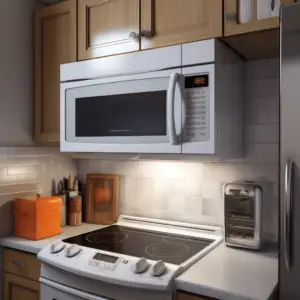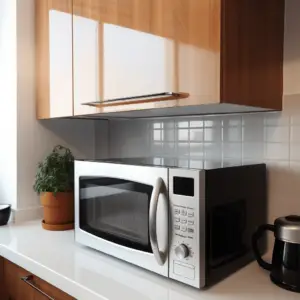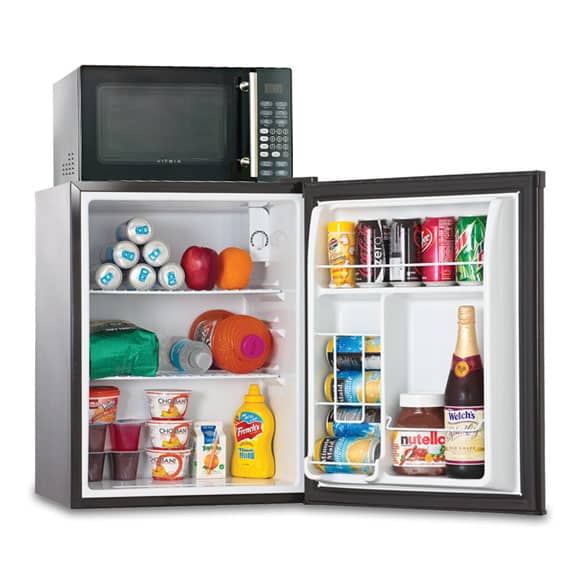Microwave Placement are a great innovation and one of the most common kitchen appliances. However, if you live in an apartment or a small house, where all available space is stretched to its limit, you may be wondering whether or not it’s safe to place something on top of the refrigerator.
Table of Contents
Can You Put A Microwave On Top Of The Fridge? What you need to know

The simple answer is yes. You can put a microwave on top of a refrigerator. However, if you have to do this, make sure you are doing it the right way for safety reasons. There are a few things you should consider such as wattage, height, weight, and ventilation of your microwave.
While that’s just an overview, there’s more to it. The following part covers all of these considerations in more detail. We will also explain whether you can put your microwave on a mini-fridge, on a washing machine as well as on a cabinet. Let’s get started!
The Weight of the Microwave
Although there’s no specific amount of weight, it is generally agreeable to place weights not exceeding 20 kg on top of your fried. Most fridges are designed to hold 15-to 20kgs, but you might come across other models that can take as much as 30kgs on top of them.
A decent microwave generally weighs around 17kgs, which is something that could easily fit within the range we have stated. There’s no need to fret so much as long as there isn’t too much weight on your cooling appliance. However, we would still insist you get a microwave stand as it can hold the weight much better and safer.
Note: if your specific microwave is particularly heavy, it could possibly dent the top of your refrigerator. It is recommended to go through the manual of your appliance to see anything about placing items on top or how much weight it can withstand without risking damage.
How Much Weight Can You Put on a Refrigerator Shelf?
A refrigerator shelf can easily accommodate weights of up to 50lbs, but this is only for the full-scale areas. For the half options, you can expect the fridge shelf to hold up to 25lbs. For the half-shelf areas, you should expect the fridge shelf to accommodate up to 25lbs.
This is not too much weight and since the technology is still evolving, manufacturers are building fridge shelves that maintain their strength over the years. Refrigerator shelves are great for larger families and the best way to know what fridge shelf is best suited for you is to determine the amount of weight the shelf can accommodate.
You will need to make sure the microwave fits properly on top of the fridge, as some microwaves are larger than the top of the fridge. Check that it sits securely and will not fall, slide or tilt in any direction.
Another thing to keep in mind is any kitchen cabinets above the refrigerator that takes up more space. This would make it harder and rather unsafe to put a microwave on top of the fridge.
Can You Place a Microwave on a Mini-Fridge?
While you can possibly place a microwave on top of a mini-fridge, it’s important to check that you’re doing it safely. Just like a standard size refrigerator, you need to consider a few things including weight, height, wattage, as well as the ventilation of your microwave.
The Ventilation of the Microwave
Microwaves that are designed for countertop use are mostly vented from the back or sides. In the event that the fridge is an open area, then microwave ventilation should not be affected by placing it on top.
That said, though, the heat emitted from the microwave may cause the compressor of the fridge to kick in more than it would without the microwave on top. This will slightly affect the performance of the refrigerator over time.
According to the instructions for the modern microwave, these appliances should be installed on a flat, solid while ensuring a gap between the microwave and surrounding items. This will help to ensure ventilation of heated air through special openings.
Even so, these instructions do not indicate anything about placing the microwave in the refrigerator. Still, you shouldn’t put a microwave oven near hot surfaces such as a radiator and stove.
Safety Concerns to Keep In Mind

At this point, you already know that you can put your microwave on top of your fridge. However, there are some safety concerns that you should be aware of. For instance, you will need to know the height and weight of your refrigerator.
The top of the fridge can potentially leak food and liquids. This risk increases if the microwave is in the fridge. Food and liquids leak more when the microwave is on a higher fridge.
Microwave Placement also needs to consider the voltage of the microwave and fridge, which will share a plug. Depending on model, most microwave ovens need 500 to 800 watts.
However, refrigerators need 725–1,000 watts. Microwave installation requires checking that the socket can handle the voltage of the two appliances when plugged in together. This brings us to the next point:
Can a Microwave and Refrigerator Be on the Same Circuit?
Technically, a microwave and a refrigerator can be on the same circuit. However, it’s recommended not to do so. Some manufacturers clearly suggest not connecting other household appliances to the same outlet as the refrigerator.
Modern refrigerators are typically complex household appliances, and they serve according to present programs with the slightest voltage surge because a connected unit in one outlet will fail, which is not pleasant for a refrigerator. The best option, therefore, is to extend a separate branch from the same outlet to connect other household appliances.


